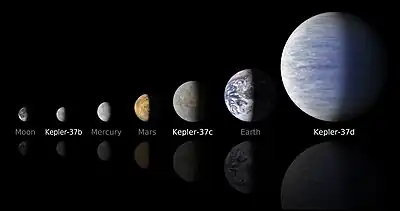 Artist's impression of Kepler-37b. | |
| Discovery[1] | |
|---|---|
| Discovery site | Kepler space telescope |
| Discovery date | February 20, 2013 |
| Transit | |
| Orbital characteristics[2] | |
| 0.1019±0.0014 AU | |
| Eccentricity | <0.098 |
| 13.367020(60) d | |
| Inclination | 88.63°+0.30° −0.53° |
| Star | Kepler-37 |
| Physical characteristics[2] | |
Mean radius | 0.3098+0.0059 −0.0076 R🜨 |
| Mass | <0.79 M🜨[lower-alpha 1] |
| Temperature | 718±10 K (445 °C; 833 °F, equilibrium) |
Kepler-37b is an exoplanet orbiting the star Kepler-37 in the constellation Lyra.[3] As of February 2013 it is the smallest planet discovered around a main-sequence star, with a radius slightly greater than that of the Moon and slightly smaller than that of Mercury.[4] The measurements do not constrain its mass, but masses above a few times that of the Moon give unphysically high densities.[5]
Characteristics

Mass, radius and temperature
| Earth | Kepler-37b |
|---|---|
 |
Kepler-37b is a sub-Earth, an exoplanet with a radius and mass smaller than Earth. Its equilibrium temperature is 718 K (445 °C; 833 °F).[2] Because of its small size, it is not expected to have an atmosphere.[6] Its radius is approximately 0.31 R🜨 (about 1,980 kilometres (1,230 mi)),[2] slightly larger than the Moon[7] (0.27 R🜨), but a little smaller than Mercury (0.38 R🜨). Due to its small size, it is very likely Kepler-37b is a rocky planet with a solid surface.[6] Furthermore, it is too hot to support liquid water on its surface.[6]
Host star
The planet orbits a (G-type) star similar to the Sun, named Kepler-37, orbited by a total of four planets. The star has a mass of 0.80 M☉ and a radius of 0.79 R☉. It has a temperature of 5417 K and is 5.66 billion years old. In comparison, the Sun is 4.6 billion years old[8] and has a temperature of 5778 K.[9]
The star's apparent magnitude, or how bright it appears from Earth's perspective, is 9.71. Therefore, it is too dim to be seen with the naked eye.
Orbit
Kepler-37b orbits its parent star at a distance of about 15 million kilometers (9.3 million miles), with a period of roughly 13 days at a distance of 0.1 AU (compared to Mercury's distance from the Sun, which is about 0.38 AU).[4] The outer two planets in the system have orbital periods[1][10] within one percent of the 8:5 and 3:1 resonances with Kepler-37b's period.
Discovery
Kepler-37b, along with two other planets, Kepler-37c and Kepler-37d, were discovered by the Kepler space telescope, which observes stellar transits.[1][6] After observing transits of Kepler-37b, astronomers had to compare it with the size of the parent star.
The size of the star was obtained using asteroseismology;[7] Kepler-37 is currently the smallest star to be studied using this process.[6] This allowed the size of Kepler-37b to be determined "with extreme accuracy".[6]
To date, Kepler-37b is the smallest planet discovered around a main-sequence star[lower-alpha 2] outside the Solar System.[4] Detection of Kepler-37b was possible due to its short orbital period, relative brightness, and low activity of its host star, allowing brightness data to average out quickly.[11] The discovery of Kepler-37b has led Jack Lissauer, a scientist at NASA's Ames Research Center, to conjecture that "such little planets are common".[6]
See also
Notes
- ↑ Masses more than a few times that of the Moon result in unphysically high densities.
- ↑ The pulsar planet PSR B1257+12 A has a comparable mass. The actual size of PSR B1257+12 A is unknown, but is likely comparable to Kepler-37b.
References
- 1 2 3 Barclay, T.; Rowe, J. F.; Lissauer, J. J.; Huber, D.; Fressin, F.; Howell, S. B.; Bryson, S. T.; Chaplin, W. J.; Désert, J. M. (2013-02-20). "A sub-Mercury-sized exoplanet". Nature. 494 (7438): 452–4. arXiv:1305.5587. Bibcode:2013Natur.494..452B. doi:10.1038/nature11914. ISSN 0028-0836. PMID 23426260. S2CID 205232792.
- 1 2 3 4 Bonomo, A. S.; Dumusque, X.; et al. (April 2023). "Cold Jupiters and improved masses in 38 Kepler and K2 small-planet systems from 3661 high-precision HARPS-N radial velocities. No excess of cold Jupiters in small-planet systems". Astronomy & Astrophysics. arXiv:2304.05773. doi:10.1051/0004-6361/202346211. S2CID 258078829.
- ↑ "Smallest Alien Planet Kepler-37b Explained (Infographic)". space.com. 20 February 2013. Retrieved 5 October 2017.
- 1 2 3 "Tiniest Planet Yet Discovered by NASA Outside our Solar System". scienceworldreport.com. February 21, 2013. Retrieved February 21, 2013.
- ↑ Marcy, Geoffrey W.; Isaacson, Howard; Howard, Andrew W.; Rowe, Jason F.; Jenkins, Jon M.; Bryson, Stephen T.; Latham, David W.; Howell, Steve B.; Gautier, Thomas N.; Batalha, Natalie M.; Rogers, Leslie; Ciardi, David; Fischer, Debra A.; Gilliland, Ronald L.; Kjeldsen, Hans; Christensen-Dalsgaard, Jørgen; Huber, Daniel; Chaplin, William J.; Basu, Sarbani; Buchhave, Lars A.; Quinn, Samuel N.; Borucki, William J.; Koch, David G.; Hunter, Roger; Caldwell, Douglas A.; Van Cleve, Jeffrey; Kolbl, Rea; Weiss, Lauren M.; Petigura, Erik; et al. (2014). "Masses, Radii, and Orbits of Small Kepler Planets: The Transition from Gaseous to Rocky Planets". The Astrophysical Journal Supplement Series. 210 (2): 20. arXiv:1401.4195. Bibcode:2014ApJS..210...20M. doi:10.1088/0067-0049/210/2/20. S2CID 10760418.
- 1 2 3 4 5 6 7 "NASA's Kepler Mission Discovers Tiny Planet System". NASA. February 20, 2013. Retrieved February 21, 2013.
- 1 2 "Astronomers Find the Tiniest Exoplanet Yet". Slate. February 20, 2013. Retrieved February 21, 2013.
- ↑ Fraser Cain (16 September 2008). "How Old is the Sun?". Universe Today. Retrieved 19 February 2011.
- ↑ Fraser Cain (15 September 2008). "Temperature of the Sun". Universe Today. Retrieved 19 February 2011.
- ↑ "Kepler-37 System". kepler.nasa.gov. Archived from the original on May 16, 2013. Retrieved February 21, 2013.
- ↑ "Small Planets Confirm Kepler's Capabilities". www.centauri-dreams.org. Retrieved 5 October 2017.



